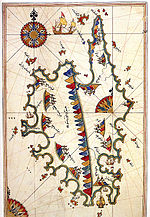
Filippo Antonio Pasquale de' Paoli was a Corsican patriot, statesman, and military leader who was at the forefront of resistance movements against the Genoese and later French rule over the island. He became the President of the Executive Council of the General Diet of the People of Corsica and wrote the Constitution of the state.
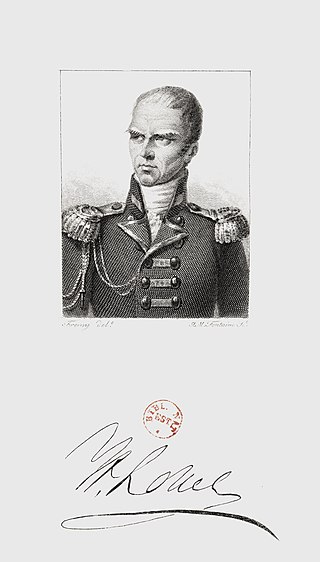
Sir Hudson Lowe was an Anglo-Irish soldier and colonial administrator who is best known for his time as Governor of St Helena, where he was the "gaoler" of the Emperor Napoléon.

Corsica is an island in the Mediterranean Sea and one of the 18 regions of France. It is the fourth-largest island in the Mediterranean and lies southeast of the French mainland, west of the Italian Peninsula and immediately north of the Italian island of Sardinia, which is the land mass nearest to it. A single chain of mountains makes up two-thirds of the island. As of January 2023, it had a population of 351,255.

The history of Corsica goes back to antiquity, and was known to Herodotus, who described Phoenician habitation in the 6th century BCE. Etruscans and Carthaginians expelled the Phoenicians, and remained until the Romans arrived during the Punic Wars in 237 BCE. Vandals occupied it in 430 CE, followed by the Byzantine Empire a century later.

Italian irredentism in Corsica was a cultural and historical movement promoted by Italians and by people from Corsica who identified themselves as part of Italy rather than France, and promoted the Italian annexation of the island.

In November 1755, Pasquale Paoli proclaimed Corsica a sovereign nation, the Corsican Republic, independent from the Republic of Genoa. He created the Corsican Constitution, which was the first constitution written in Italian under Enlightenment principles, including female suffrage, later revoked by the French when they took over the island in 1769. The republic created an administration and justice system, and founded an army.

The flag of Corsica was adopted by General of the Nation Pasquale Paoli in 1755 and was based on a traditional flag used previously. It portrays a Moor's head in black wearing a white bandana above his eyes on a white background. Previously, the bandana covered his eyes; Paoli wanted the bandana moved to above the eyes to symbolise the liberation of the Corsican people from the Genoese.

The Anglo-Corsican Kingdom, also known as the Kingdom of Corsica, was a client state of the Kingdom of Great Britain that existed on the island of Corsica between 1794 and 1796, during the French Revolutionary Wars.
The Corsican Crisis was an event in British politics during 1768–69. It was precipitated by the invasion of the island of Corsica by France. The British government under the Duke of Grafton failed to intervene, for which it was widely criticised and was one of many factors that contributed to its downfall in early 1770.

The Invasion of Corsica of 1553 occurred when French, Ottoman, and Corsican exile forces combined to capture the island of Corsica from the Republic of Genoa.

The siege of Calvi was a combined British and Corsican military operation during the Invasion of Corsica in the early stages of the French Revolutionary Wars. The Corsican people had risen up against the French garrison of the island in 1793, and sought support from the British Royal Navy's Mediterranean Fleet under Lord Hood. Hood's fleet was delayed by the Siege of Toulon, but in February 1794 supplied a small expeditionary force which successfully defeated the French garrison of San Fiorenzo and then a larger force which besieged the town of Bastia. The British force, now led by General Charles Stuart, then turned their attention to the fortress of Calvi, the only remaining French-held fortress in Corsica.
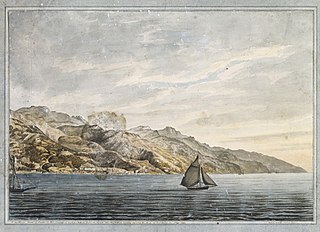
The siege of Bastia was a combined British and Corsican military operation during the early stages of the French Revolutionary Wars. The Corsican people had risen up against the French garrison of the island in 1793, and sought support from the British Royal Navy's Mediterranean Fleet under Lord Hood. After initial delays in the autumn, Hood had supplied a small expeditionary force which had successfully driven the French out of the port of San Fiorenzo in February 1794. Hood then turned his attention to the nearby town of Bastia, which was held by a large French garrison.

The siege of San Fiorenzo was a British military operation, supported by Corsican partisans early in the French Revolutionary Wars against the French-held town of San Fiorenzo on the Mediterranean island of Corsica. The Corsican people had risen up against the French Republican garrison in 1793 after an attempt to arrest the Corsican leader Pasquale Paoli during the Reign of Terror. The French had then been driven into three fortified towns on the northern coast; San Fiorenzo, Calvi, and Bastia and Paoli appealed to the British Royal Navy's Mediterranean Fleet, commanded by Lord Hood, for assistance against the French garrison.

The French conquest of Corsica was a successful expedition by French forces of the Kingdom of France under Comte de Vaux, against Corsican forces under Pasquale Paoli of the Corsican Republic. The expedition was launched in May 1768, in the aftermath of the Seven Years' War. A French expeditionary force was landed on the island of Corsica, then ruled by the Corsican Republic. Marching inland to overcome any Corsican opposition, the French force initially suffered an unexpected defeat at the Battle of Borgo. But a new commander, the Comte de Vaux, was appointed to lead the expedition, and decisively defeated the Corsican army at the Battle of Ponte Novu in 1769, effectively bringing an end to Corsican resistance.
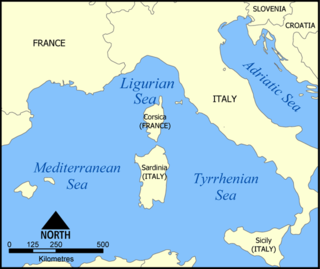
The Italian occupation of Corsica refers to the military occupation by the Kingdom of Italy of the French island of Corsica during the Second World War, from November 1942 to September 1943. After an initial period of increased control over the island, by early spring 1943 the Maquis had begun to occupy the hinterland. In the aftermath of the Armistice of Cassibile, the Italian capitulation to the Allies, some Italian units sided with German troops sent to replace the Italian garrison and some defected to the Maquis and Free French Forces.

The invasion of Corsica was a campaign fought in the spring and summer of 1794 by combined British military and Corsican irregular forces against a French garrison, early in the French Revolutionary Wars. The campaign centred on sieges of three principal towns in Northern Corsica; San Fiorenzo, Bastia and Calvi, which were in turn surrounded, besieged and bombarded until by August 1794 French forces had been driven from the island entirely.

The Mediterranean campaign of 1793–1796 was a major theater of conflict in the early years of the French Revolutionary Wars. Fought during the War of the First Coalition, the campaign was primarily contested in the Western Mediterranean between the French Navy's Mediterranean Fleet, based at Toulon in Southern France, and the British Royal Navy's Mediterranean Fleet, supported by the Spanish Navy and the smaller navies of several Italian states. Major fighting was concentrated in the Ligurian Sea, and focused on British maintenance of and French resistance to a British close blockade of the French Mediterranean coast. Additional conflict spread along Mediterranean trade routes, contested by individual warships and small squadrons.

The action of 22 October 1793 was a minor naval engagement fought in the Mediterranean Sea during the War of the First Coalition, early in the French Revolutionary Wars. During the engagement a lone British Royal Navy ship of the line, the 64-gun HMS Agamemnon, attacked the French Navy large frigate Melpomène, part of a larger squadron, off the coast of Sardinia. Although Agamemnon chased Melpomène some distance through the night and inflicted significant damage, the French frigate was able to escape following the arrival of the rest of its squadron under Commodore Jean-Baptiste Perrée. The French ships later anchored in Corsican harbours to land reinforcements for the French garrison on the island, where the population was in open revolt.

The French expedition to Sardinia was a short military campaign fought in 1793 in the Mediterranean Sea in the first year of the War of the First Coalition, during the French Revolutionary Wars. The operation was the first offensive by the new French Republic in the Mediterranean during the conflict, and was directed at the island of Sardinia, part of the Kingdom of Sardinia. Sardinia was neutral at the time, but immediately joined the anti-French coalition. The operation was a failure, with attacks directed at Cagliari in the south and La Maddalena in the north both ending in defeat.
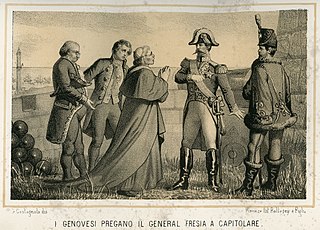
The siege of Genoa on 13–18 April 1814 was the capture of the port city of Genoa by a British–Sicilian army from the First French Empire. It was the last battle of the War of the Sixth Coalition's Italian campaign, as on 4 April, Napoleon had abdicated as emperor of France.
